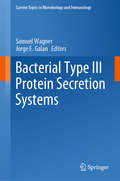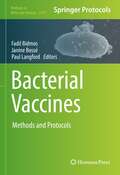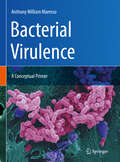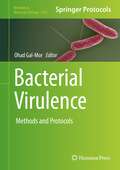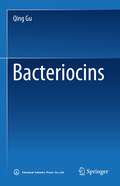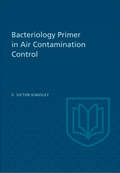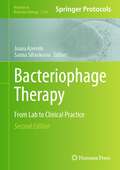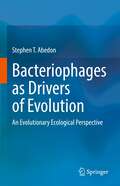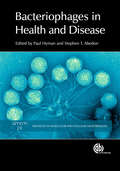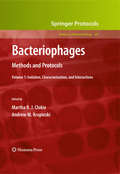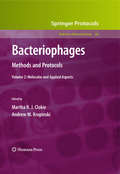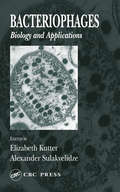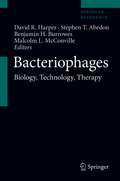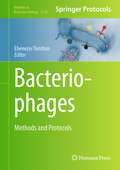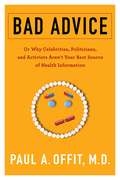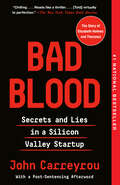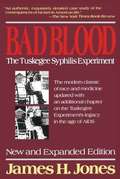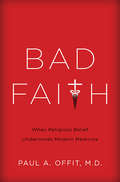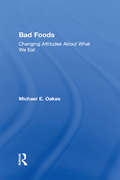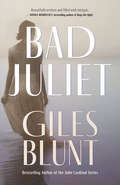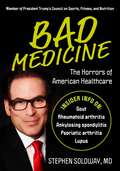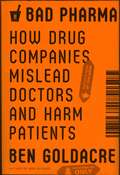- Table View
- List View
Bacterial Type III Protein Secretion Systems (Current Topics in Microbiology and Immunology #427)
by Samuel Wagner Jorge E. GalanOne of the most exciting developments in the field of bacterial pathogenesis in recent years is the discovery that many pathogens utilize complex nanomachines to deliver bacterially encoded effector proteins into eukaryotic and prokaryotic target cells to modulate a variety of cellular functions for the pathogen’s benefit. These protein-delivery machines include the type III secretion system (T3SS), which is widespread in nature and encoded not only by bacteria pathogenic to vertebrates or plants, but also by bacteria that are symbiotic to plants or insects. Because they are essential virulence factors for many important human pathogens, these systems are emerging as a prime target for the development of new-generation, anti-infective drugs. This book reviews our current understanding of these intriguing injection machines as well as of the closely related T3SS that serves in flagella assembly. Individual chapters focus on regulation, assembly, structure, and function of the type III secretion machine and on the evolution of the secreted effector proteins. Given its scope, this book will appeal to a broad readership, including researchers and teachers in the fields of infectious diseases, host pathogen interactions, plant and animal pathogenesis, and symbiosis.
Bacterial Vaccines: Methods and Protocols (Methods in Molecular Biology #2414)
by Paul Langford Fadil Bidmos Janine BosséThe importance of vaccines to combat bacterial diseases cannot be overstated. Methods used in the development and testing of these vaccines are evolving rapidly as a direct consequence of the availability of advanced technologies. This volume will cover methods developed in the last decade, the usage of which are enabling the development of cheaper, cost-effective and structurally stable vaccines for global use. Chapters cover in silico analytical methods such as reverse vaccinology and machine learning; low-energy electron irradiation for the generation of inactivated bacterial vaccines; methods for assessment of OMV/GMMA quality and stability; and controlled human infection models. Written in the highly successful Methods in Molecular Biology series format, chapters include introductions to their respective topics, lists of the necessary materials and reagents, step-by-step, readily reproducible laboratory protocols, and tips on troubleshooting and avoiding known pitfalls. Cutting-edge and comprehensive, Bacterial Vaccines: Methods and Protocols is a valuable resource for novice and expert researchers interested in learning more about this important and constantly evolving field.
Bacterial Virulence: A Conceptual Primer
by Anthony William MaressoThis textbook introduces in an engaging way the fundamentals of how pathogenic bacteria interact with, and are virulent within, the human host. To inspire and educate the next generation of microbe hunters, the author, Microbiologist and Scientist Anthony William Maresso, integrates the major findings of the field into a single, easy-to-understand volume emphasizing a molecular appreciation of the concepts underlying bacterial infectious diseases. The work explores such themes as the history of Microbiology, bacterial structure and physiology, bacterial toxins, secretion systems, and adhesins, the host immune system and its battle with bacteria, biofilms, sepsis, and technologies/techniques to the present day. Fully illustrated in concept and packed with idea-provoking challenges highlighting “out-of-the-box” thinking, the work moves beyond being just a review of the scientific literature intent on equipping the next generation of Microbiologists and their teachers with the knowledge to confront, and hopefully one day defeat, the insidious microbes which undermine human health. This textbook is a resource for undergraduate, graduate, and medical students, as well as other health-oriented learners, postdoctoral scholars, basic scientists, and professors intent on expanding their knowledge of bacterial infection and virulence mechanisms.
Bacterial Virulence: Methods and Protocols (Methods in Molecular Biology #2427)
by Ohad Gal-MorThis detailed volume explores the field of bacterial virulence and the effort to understand how microbial interaction with a host results in the pathology of a specific disease. This collection of selected protocols includes advanced molecular biology and bioinformatics methods, cell culture and organoid models of infection, as well as in vivo infection models that are useful to study the interaction of pathogens with plants, insects, avian, and mammalian hosts. Written for the highly successful Methods in Molecular Biology series, chapters include introductions to their respective topics, lists of the necessary materials and reagents, step-by-step, readily reproducible protocols, and tips on troubleshooting and avoiding known pitfalls. Authoritative and beneficial, Bacterial Virulence: Methods and Protocols serves as an ideal guide for researchers seeking to promote and further develop the exciting and continuously evolving field of bacterial virulence.Chapter 19 is available open access under a Creative Commons Attribution 4.0 International License via link.springer.com.
Bacterial Volatile Compounds as Mediators of Airborne Interactions
by Birgit Piechulla Choong-Min Ryu Laure WeisskopfThis book covers the fundamentals of bacterial volatile-mediated communication with other organisms, starting with the biosyntheses of volatile organic compounds (VOC), interactions with plants and animals, interactions with microbes, tools for data analysis, and their applications. With this foundation in place, the book subsequently focuses on understanding the effect of bacterial volatiles on plant growth promotion, discusses plant immunity, and lastly shares insights into future research directions. The book is divided into fourteen-in-depth chapters, each of which is designed to enrich readers’ understanding of bacterial volatile compounds’ functions and various applications.The pivotal roles of bacterial volatile compounds make this book essential reading for scientists and students of all biological disciplines seeking to fully understand microorganism responses and environmental adaptations. In addition to its value as a fundamental book for graduate students, it offers a clearly structured reference guide for all individuals working in microbiology.
Bacteriocins
by Qing GuThis book intends to report the new results of the study of bacteriocins, from basic research to application fields. It mainly introduces the biological characteristics of bacteriocins, the relationship between their structure and function, the antibacterial mode of action, and their application as antibacterial agents in food industry, medical care, and other areas, especially their application potential in human health. This book can be used as a reference book for researchers, undergraduates, and graduated students in the professional fields of food science and engineering, bioengineering, medicine, and agriculture.
Bacteriology Primer in Air Contamination Control
by Van KingsleyThis primer is directed to air contamination control personnel, air engineers, whose only contact with bacteriology is usually their responsibility for providing "white" surroundings in industry and research. Professor Kingsley provides most basic information and describes problems in bacteriology which would help in the understanding, handling, and moving of "clean" (uncontaminated) air to and from critical areas. Divided into three parts, the manual includes sections on "Basic Principles of Bacteriology," "Bacteriology in the Air" and "The Sampling of Airborne Microorganisms." A glossary of bacteriological terms and graphs supplements the text.
Bacteriophage Therapy: From Lab to Clinical Practice (Methods in Molecular Biology #2734)
by Joana Azeredo Sanna SillankorvaThis highly anticipated second edition details cutting-edge experimental approaches for bacteriophage research. This comprehensive volume details new and updated experimental approaches for isolating, formulating, and engineering bacteriophage medicinal products. Authored by leading experts and written in the highly successful Methods in Molecular Biology series format, each chapter includes introductions to their respective topics, lists of the necessary materials and reagents, step-by-step reproducible laboratory protocols, and valuable tips for troubleshooting and avoiding known pitfalls. Whether you are a seasoned scientist or a newcomer, Bacteriophage Therapy: From Lab to Clinical Practice, Second Edition provides essential tools and knowledge to advance bacteriophage research and its translation into innovative medicinal products and clinical therapies.
Bacteriophages as Drivers of Evolution: An Evolutionary Ecological Perspective
by Stephen T. AbedonThis monograph emphasizes the many facets of bacterial evolution as impacted by bacterial interactions with phages, as well as, to a lesser degree, the evolutionary impact of phages on other organisms, including other phages. The book starts with a general overview of bacteriophages. Topics discussed in detail include but are not limited to mutagenesis, migration, natural selection and genetic drift as the drivers of evolution as well as an extensive discussion from the author’s unique perspective on phage ecology.
Bacteriophages in Health and Disease
by Andrew Kropinski Paul Hyman Sarah Kuhl Andre Letarov Stephen T AbedonBacteriophages are viruses that infect bacteria. As such, they have many potential uses for promoting health and combating disease. This book covers the many facets of phage-bacterial-human interaction in three sections: the role and impact of phages on natural bacterial communities, the potential to develop phage-based therapeutics and other aspects in which phages can be used to combat disease, including bacterial detection, bacterial epidemiology, the tracing of fecal contamination of water and decontamination of foods.
Bacteriophages, Volume 1: Methods and Protocols, Volume 1: Isolation, Characterization, and Interactions (Methods in Molecular Biology #501)
by Andrew Kropinski Martha R. ClokieRanging from the evolution of pathogenicity to oceanic carbon cycling, the many and varied roles that bacteriophages play in microbial ecology and evolution have inspired increased interest within the scientific community. Bacteriophages: Methods and Protocols pulls together the vast body of knowledge and expertise from top international bacteriophage researchers to provide both classical and state-of-the-art molecular techniques. With its well-organized modular design, Volume 1: Isolation, Characterization, and Interactions examines a multitude of topics, including the isolation of phages, morphological and molecular characterization, and interaction with bacteria. Written in the highly successful Methods in Molecular BiologyTM series format, chapters consist of brief introductions to the subject, lists of the necessary materials and reagents, readily reproducible laboratory protocols, and a Notes section which details tips on troubleshooting and avoiding known pitfalls.<P><P> Thorough and cutting-edge, Bacteriophages: Methods and Protocols is a valuable reference for experienced bacteriophage researchers as well as an easily accessible introduction for newcomers to the subject.
Bacteriophages, Volume 2: Methods and Protocols, Volume 2: Molecular and Applied Aspects (Methods in Molecular Biology #502)
by Andrew Kropinski Martha R. ClokieRanging from the evolution of pathogenicity to oceanic carbon cycling, the many and varied roles that bacteriophages play in microbial ecology and evolution have inspired increased interest within the scientific community. Bacteriophages: Methods and Protocols pulls together the vast body of knowledge and expertise from top international bacteriophage researchers to provide both classical and state-of-the-art molecular techniques. With its well-organized modular design, Volume 2: Molecular and Applied Aspects examines a multitude of topics, including the bacteriophage genomics, metagenomics, transcriptomics, and proteomics, along with applied bacteriophage biology. Written in the highly successful Methods in Molecular Biology™ series format, chapters consist of brief introductions to the subject, lists of the necessary materials and reagents, readily reproducible laboratory protocols, and a Notes section which details tips on troubleshooting and avoiding known pitfalls.<P><P> Thorough and cutting-edge, Bacteriophages: Methods and Protocols is a valuable reference for experienced bacteriophage researchers as well as an easily accessible introduction for newcomers to the subject.
Bacteriophages: Biology and Applications
by Elizabeth Kutter Alexander SulakvelidzeIn response to the emergence of pathogenic bacteria that cannot be treated with current antibiotics, many researchers are revisiting the use of bacteriophages, or phages, to fight multidrug-resistant bacteria. Bacteriophages: Biology and Applications provides unparalleled, comprehensive information on bacteriophages and their applications, such as
Bacteriophages: Biology, Technology, Therapy
by David R. Harper Stephen T. Abedon Benjamin H. Burrowes Malcolm L. McConvilleThis first major reference work dedicated to the mannifold industrial and medical applications of bacteriophages provides both theoretical and practical insights into the emerging field of bacteriophage biotechnology. The book introduces to bacteriophage biology, ecology and history and reviews the latest technologies and tools in bacteriophage detection, strain optimization and nanotechnology. Usage of bacteriophages in food safety, agriculture, and different therapeutic areas is discussed in detail. This book serves as essential guide for researchers in applied microbiology, biotechnology and medicine coming from both academia and industry.
Bacteriophages: Methods and Protocols (Methods in Molecular Biology #2738)
by Ebenezer TumbanThis volume provides detailed protocols for the isolation, enumeration, characterization of diverse bacteriophages, including both small to jumbo bacteriophages, from soil, fecal, municipal wastewater, and from food niche samples. Chapters highlight the diversity of bacteriophages in different environments, quantifications using culture, molecular techniques, protocols for isolate, interaction of bacteriophage proteins with host cells, and how to use bacteriophages to transfer foreign genetic elements to bacterial strains. In addition to the above, chapters feature the application of bacteriophages/bacteriophage-derived products. Written in the highly successful Methods in Molecular Biology series format, chapters include introductions to their respective topics, lists of necessary materials and reagents, step-by-step, readily reproducible laboratory protocols, and tips (in the Notes section) on troubleshooting and avoiding known pitfalls. Authoritative and cutting-edge, Bacteriophages: Methods and Protocols aims to ensure successful results in further study of this vital field.
Bad Advice: Or Why Celebrities, Politicians, and Activists Aren't Your Best Source of Health Information
by Paul OffitScience doesn’t speak for itself. Neck-deep in work that can be messy and confounding, and naïve in the ways of public communication, scientists are often unable to package their insights into the neat narratives that the public requires. Enter the celebrities, the advocates, the lobbyists, and the funders behind them, who take advantage of scientists’ reluctance to provide easy answers, flooding the media with misleading or incorrect claims about health risks. Amid this onslaught of spurious information, Americans are more confused than ever about what’s good for them and what isn’t.In Bad Advice, Paul A. Offit shares hard-earned wisdom on the do’s and don’ts of battling misinformation. For the past twenty years, Offit has been on the front lines in the fight for sound science and public heath. Stepping into the media spotlight as few scientists have done—such as being one of the first to speak out against conspiracy theories linking vaccines to autism—he found himself in the crosshairs of powerful groups intent on promoting pseudoscience. Bad Advice discusses science and its adversaries: not just the manias stoked by slick charlatans and their miracle cures but also corrosive, dangerous ideologies such as Holocaust and climate-change denial. Written with wit and passion, Offit’s often humorous guide to taking on quack experts and self-appointed activists is a must-read for any American disturbed by the recent uptick in politicized attacks on science.
Bad Blood: Secrets and Lies in a Silicon Valley Startup
by John Carreyrou<P>The full inside story of the breathtaking rise and shocking collapse of Theranos, the multibillion-dollar biotech startup, by the prize-winning journalist who first broke the story and pursued it to the end, despite pressure from its charismatic CEO and threats by her lawyers. <P>In 2014, Theranos founder and CEO Elizabeth Holmes was widely seen as the female Steve Jobs: a brilliant Stanford dropout whose startup "unicorn" promised to revolutionize the medical industry with a machine that would make blood testing significantly faster and easier. <P>Backed by investors such as Larry Ellison and Tim Draper, Theranos sold shares in a fundraising round that valued the company at more than $9 billion, putting Holmes's worth at an estimated $4.7 billion. <P>There was just one problem: The technology didn't work. <P>A riveting story of the biggest corporate fraud since Enron, a tale of ambition and hubris set amid the bold promises of Silicon Valley. <P><b>A New York Times Bestseller</b>
Bad Blood: The Tuskegee Syphilis Experiment New and Expanded Edition
by James Jones1932 - 1972 - Alabama. Describes a study in which poor African Americans were denied appropriate medical treatment.
Bad Call: A Summer Job on a New York Ambulance
by Mike ScardinoAn adrenaline-fueled read that will stay with you long after the you turn the final page, BAD CALL is a "compulsively readable, totally unforgettable"* memoir about working on a New York City ambulance in the 1960s. (*James Patterson)Bad Call is Mike Scardino's visceral, fast-moving, and mordantly funny account of the summers he spent working as an "ambulance attendant" on the mean streets of late-1960s New York. Fueled by adrenaline and Sabrett's hot dogs, young Mike spends his days speeding from one chaotic emergency to another. His adventures take him into the middle of incipient race riots, to the scene of a plane crash at JFK airport and into private lives all over Queens, where New Yorkers are suffering, and dying, in unimaginable ways. Learning on the job, Mike encounters all manner of freakish accidents (the man who drank Drano, the woman attacked by rats, the man who inflated like a balloon), meets countless unforgettable New York characters, falls in love, is nearly murdered, and gets an early and indelible education in the impermanence of life and the cruelty of chance. Action-packed, poignant, and rich with details that bring Mike's world to technicolor life, Bad Call is a gritty portrait of a bygone era as well as a bracing reminder that, though "life itself is a fatal condition," it's worth pausing to notice the moments of beauty, hope, and everyday heroism along the way.
Bad Faith: When Religious Belief Undermines Modern Medicine
by Paul A. OffitIn recent years, there have been major outbreaks of whooping cough among children in California, mumps in New York, and measles in Ohio’s Amish country--despite the fact that these are all vaccine-preventable diseases. Although America is the most medically advanced place in the world, many people disregard modern medicine in favor of using their faith to fight life threatening illnesses. Christian Scientists pray for healing instead of going to the doctor, Jehovah’s Witnesses refuse blood transfusions, and ultra-Orthodox Jewish mohels spread herpes by using a primitive ritual to clean the wound. Tragically, children suffer and die every year from treatable diseases, and in most states it is legal for parents to deny their children care for religious reasons. In twenty-first century America, how could this be happening? In Bad Faith, acclaimed physician and author Dr. Paul Offit gives readers a never-before-seen look into the minds of those who choose to medically martyr themselves, or their children, in the name of religion. Offit chronicles the stories of these faithful and their children, whose devastating experiences highlight the tangled relationship between religion and medicine in America. Religious or not, this issue reaches everyone--whether you are seeking treatment at a Catholic hospital or trying to keep your kids safe from diseases spread by their unvaccinated peers. Replete with vivid storytelling and complex, compelling characters, Bad Faith makes a strenuous case that denying medicine to children in the name of religion isn’t just unwise and immoral, but a rejection of the very best aspects of what belief itself has to offer.
Bad Foods: Changing Attitudes About What We Eat
by Michael E OakesBad Foods demonstrates how a variety of historical or political events and personalities have shaped our current views of good nutrition. On several occasions in American history concerns have arisen over the safety of our food supply (e.g., harmful ingredients in processed foods) and the potential that processing might deplete foods of their nutrients. These concerns help explain how food characteristics such as freshness, natural, organic, and unprocessed have become important to Americans.Bad Foods traces how the food nutrients fat, salt, and sugar have acquired negative reputations for health as well as any controversies and outright misconceptions of the dangers of these nutrients. Bad Foods also explores confusion that can in part be attributed to biased media coverage about foods. Modern Americans are routinely bombarded with information about the health value of certain foods and the dangers of others. Frequently, health information about certain nutrients receives exaggerated coverage (e.g., dietary fat) while the importance of other nutrients gets ignored (e.g., vitamins and minerals). Moreover, health information about foods is often perceived as contradictory.While some readers may be startled by what they perceive to be a challenge to sacred beliefs about foods, others will see the honesty in both the research and the writing and recognize the social benefits of examining our beliefs about foods. Bad Foods will be of interest to sociologists, food science specialists, and social historians.
Bad Juliet
by Giles BluntAt a tuberculosis sanitarium in the Adirondacks, a young tutor falls in love with a mysterious woman who survived the Lusitania disaster.“Bad Juliet will hold you in its grip from its opening pages, combining the pacing and twists of a thriller with the compelling characterizations and masterful prose of a writer at the top of his form.” — Nino Ricci, award-winning author of The Origin of SpeciesRecently jilted by his fiancé, Paul Gascoyne takes a job as a tutor to the patients at the Trudeau Sanitarium in upstate New York. There, in the icebound beauty of the Adirondack Mountains, he finds himself drawn to Sarah Ballard, a beautiful but enigmatic young woman, traumatized by her past aboard the ill-fated ship Lusitania. To rouse her out of her gloom, Paul encourages her to write a memoir.As Paul reads her words, it gradually becomes clear that Sarah’s memories are a tangle of truth and fiction that he can’t begin to unravel. And yet he cannot overcome his attraction to her. When a terrible relapse leaves Sarah worried that she has little time left, she begs Paul to be the one person in the world who will truly know her.
Bad Medicine: Medical Thriller
by Eileen Dreyer"Powerful, immensely rich in detail, legend, character, this is a must read." ~Verified reviewerTrauma nurse and part-time death-investigator Molly Burke is having a pretty normal night at her St. Louis Emergency Department. Then a well-connected lawyer is wheeled in, victim of a suspected suicide.One suicide is bad. But when one grows to four in a matter of days, and all the victims are lawyers, the trend stops being an oddity and becomes a real problem.Were these really suicides? Why would successful, hot young lawyers want to kill themselves? Then Molly unearths secrets that powerful people don’t want exposed and the puzzle suddenly becomes a threat. Now she must find killer, or become the next victim."With her own unique blend of dark humor, complex motivations and riveting suspense, Eileen Dreyer is a very tough act to beat. A nerve-shattering suspense." ~RT MagazinePublisher's Note: As a former trauma nurse, Eileen Dreyer combines her real-world medical knowledge and superb story-telling to bring readers a series of uniquely plotted, spine-tingling, medical mysteries. Fans of Tami Hoag, Elizabeth George, Nora Roberts as well as John Lutz, Michael Crichton and Patricia Cornwell will enjoy these well-crafted medical thrillers. OTHER MEDICAL SUSPENSE/THRILLERS by Eileen Dreyer:Nothing PersonalBrain DeadBad MedicineIf Looks Could Kill
Bad Medicine: The Horrors of American Healthcare
by Dr. Stephen SolowayWhat you don&’t know about the American healthcare system might kill you. From fatal malpractice to Medicare fraud, Dr. Stephen Soloway has seen it all over his thirty years practicing medicine. Now, the man known as &“Dr. Trump&” is ripping off the Band-Aid and exposing the truth about the American healthcare system—the good, the bad, and the rotten. Page after shocking page, you&’ll discover the truth about where the coronavirus came from, and if we&’ll ever be able to cure it. Learn the sad reality of what Medicare for All would mean for our nation. Find out why you should stay away from hospitals as if your life depended on it. (It does.) Dr. Soloway explains the medical tips and tricks that could save you from amputations, years of pain, or even death. Appointed by President Donald Trump to the President's Council on Sports, Fitness, and Nutrition, Dr. Soloway is a leader in his field, who sat on numerous boards and panels in the pharmacological industry, along with national advisory panels for major companies involved in arthritis or osteoporosis research. His uncanny ability to diagnose even the most complex cases has earned him the reputation of being a real-life Dr. House—minus the pill problem. Beyond his savvy insights into the secrets of our medical system, Dr. Soloway also shares his own rags to riches story, and how dedicated medical professionals can still succeed in this difficult environment. Ultimately, Dr. Soloway has a diagnosis for all Americans: Our healthcare system—and our country as a whole—is headed for disaster. The prescription? Read this book to find out.
Bad Pharma: How Drug Companies Mislead Doctors And Harm Patients
by Ben GoldacreWe like to imagine that medicine is based on evidence and the results of fair testing and clinical trials. In reality, those tests and trials are often profoundly flawed. We like to imagine that doctors who write prescriptions for everything from antidepressants to cancer drugs to heart medication are familiar with the research literature about a drug, when in reality much of the research is hidden from them by drug companies. We like to imagine that doctors are impartially educated, when in reality much of their education is funded by the pharmaceutical industry. We like to imagine that regulators have some code of ethics and let only effective drugs onto the market, when in reality they approve useless drugs, with data on side effects casually withheld from doctors and patients. All these problems have been shielded from public scrutiny because theyre too complex to capture in a sound bite. But Ben Goldacre shows that the true scale of this murderous disaster fully reveals itself only when the details are untangled. He believes we should all be able to understand precisely how data manipulation works and how research misconduct in the medical industry affects us on a global scale. With Goldacres characteristic flair and a forensic attention to detail, "Bad Pharma "reveals a shockingly broken system and calls for regulation. This is the pharmaceutical industry as it has never been seen before.
